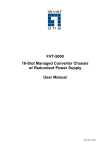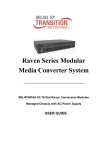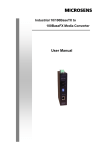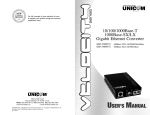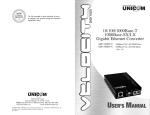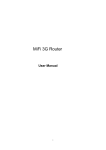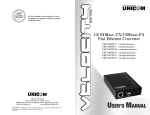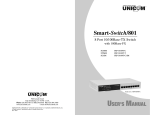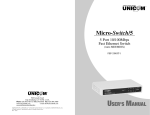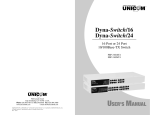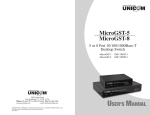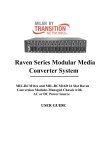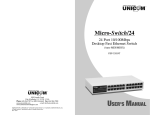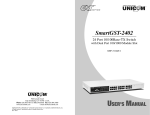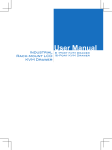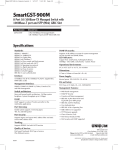Download USER`S MANUAL Smart-Chassis/16
Transcript
For full coverage of your warranty, be sure to register your product using the enclosed registration card. Smart-Chassis/16 16 Bay Managed Media Converter Chassis FEP-682116 908 Canada Court City of Industry, CA 91748 U.S.A. Phone: 626.964.7873 or 800.346.6668 Fax: 626.964.7880 www.unicomlink.com e-mail: [email protected] ©UNICOM 2003. UNICOM and “A Network Systems Solution” are trademarks of UNICOM Electric, Inc. All rights reserved. Specifications subject to change without notice. Rev: 05.03 USER’S MANUAL 1. Introduction Congratulations on purchasing a quality UNICOM product. Unicom’s Smart-Chassis/16 represents the newest, most advanced generation of signal conversion technology. The Smart-Chassis/16 is a heavy-duty enclosure that provides compact management of up to 16 optional modular converter units. This management creates a flexible networking environment. Also, all converter bays are isolated from the power bus making all converters hot- swappable for minimal system downtime. Figure 1-1 the Smart-Chassis/16 Managing and configuring the Smart-Switch/16 is easy with its built-in Webbased Management features, Via a Web Browser. You can enact global as well as specific bay changes. The Smart-Chassis/16 can also be managed via Telnet, Console, or third party SNMP Management. Features Conforms to the IEEE 802.3, 802.3u, 802.3ab, and 802.3z Standard Capacity for sixteen converters and two power supplies Modules and CPU module are hot-swappable Supports Fast Ethernet and Gigabit modules, Single Mode or Multi-Mode AC/DC power with Redundant HTTP, Telnet security IP address security for management station Firmware upgrade via web interface Link Lost Forwarding (LLF) Module identification SNMP, Web, Telnet, console management Event log and SNMP Trap support SNMP MIB II and private MIB supports EIA RS-310C 19 “ standard Software Features Management Telnet, Web, and Console (RS-232) Web/Telnet Web and Telnet function can be enabled or disabled. MIBS RFC 1213 MIB II, Private MIB Link down, Link up, Power module status change, SNMP Trap authorization Fail, Module plug in and plug out, chassis configuration change, module configuration change. Software Upgrade Firmware upgrade via web interface Each module supports LLF feature. It can be set through the web interface or the CLI menu. Link Lost LLF Mode TX Fiber: TX port link down, the fiber port Forwarding will be forced down LLF Mode Fiber TX: Fiber port link down, the TX port will be forced down TX port: IN-good / In-bad packet counter, out-good /out- Packet counter bad packet counter, collision counter Fiber port: IN-good / In-bad packet counter, out-good /out-bad packet counter, collision counter SNMPTrap Node IP security Module notice Events log Up to 4 Trap nodes. It supports IP security for telnet, HTTP and SNMP access. Up to 4 IP nodes when security is enabled. Each module can add notices for information allocation (up to 32 characters). Up to 4095 event records. They can be reviewed via the CLI or Web interface. Management Methods The Smart-Chassis/16 supports the following management methods: Console and Telnet Management Web-based Management SNMP Network Management Console and Telnet Management Console Management is done through the RS-232 Console Port. This requires a direct connection between PC and the Chassis. The Telnet management is done through the network. Once the Chassis is on the network, you can use the Telnet program to Log in and modify the configuration. Web-based Management The Smart-Chassis/16 provides an embedded HTML web program in flash memory. It offers advanced management features and allows users to manage the chassis from anywhere on the network through a standard browser such as Microsoft Internet Explorer. For more information, see Section 5 Web-Based Management. SNMP Network Management SNMP (Simple Network Management Protocol) provides a way to monitor and control network behaviors, such as configurations, statistic collection, performance, and security. Data is collected by SNMP agents, which are hardware and software processes reporting activity in each network device. The agents report information contained in an MIB format (Management Information Base), which is a data structure that defines what is obtainable from the device and what can be controlled. Package Contents Unpack the carton of the Smart-Chassis/16 and verify them against the checklist below. Smart-Chassis/16 Power Cord Four Rubber Feet RS-232 cable User Guide Smart-Chassis/16 RS-232 cable Rubber Feet User Guide Rack-mounted Kit Power Cord Figure 1-2. Package Contents If any item is missing or damaged, please contact your local dealer for service. 2. Hardware Description The Smart-Chassis/16 is a modular unit that contains 16 module slots and 2 power slots. Both an RS-232 port, used for Out-of-Band Management, and an Ethernet RJ-45 connector, for In-Band Management, are on the front panel. Front and Rear Panel Figure 2-1 shows the front panel of Smart-Chassis/16 filled with modules (16 modules, sold separately). Figure 2-1. Front Panel The 3-pronged power plug is located at the Rear Panel of the SmartChassis/16 as shown in Figure 2-2. The power is AC in the range 100-240VAC, 50-60Hz (AC type power supply) or DC power in the range 40.5 ~57.0 @ 20A. (DC type power supply). The Factory Default is one power and fan module but another power module may be added for power redundancy. [Notice] AC power and DC Power cannot be installed simultaneously. Power Slot B Power Slot A with fan unit with AC Power Figure 2-2. Rear Panel of the Smart-Chassis/16 LED Indicators All LED status indicators are located on the FRONT panel of the chassis. They provide real-time indication of system and operational status. The ports for connections to other devices and networks are also on the front panel. CPU Panel LED Status Meaning CPU Ready Green (Blinking) System kernel is working correctly PWR Green Power on Green Power Module A is ready Off Power Module A is not ready Green Power Module B is ready Off Power Module B is not ready Orange Power Module A has failed or is not present Off Power Module A is ready Orange Power Module B has failed or is not present Off Power Module B is ready Green Ethernet port is connecting with the device. Blinking The port is receiving or transmitting data Yellow Ethernet is link in Full Duplex mode Blinking Packet collision occurring (half-duplex) T bl 2 1 D i ti Good A Good B Fail A Fail B LK/ACT FDX f th CPU LED 3. Connecting to the Network This chapter provides the installation procedure and instructions for assigning IP addresses. Pre-Installation Requirements Before you start the hardware installation, make sure your installation environment has the following items: PCs with 10/100Base-TX Ethernet cards: the PC must have a standard Ethernet interface to connect with the chassis UTP cable with RJ-45 connector: Verify that the cable and connectors are working properly. Fiber cable with SC/ST/MT-RJ connector: Verify that the cable and connectors are the proper types. A power outlet: 100 to 240V AC at 50 to 60 Hz or DC power. Make sure that the chassis' power is accessible and that cables can be connected easily. Dedicated power supply: Use dedicated power circuits or power conditioners to supply reliable electrical power to the network devices. A dry cool place: Keep the chassis away from moisture. Avoid direct sunlight, heat sources, and area with a high amount of electromagnetic interference. Mounting tools: If you intend to mount the chassis on a rack, make sure you have the tools and supplies, such as mounting brackets and screws. Mounting the Chassis The Smart-Chassis/16 is suitable for an office environment where it can be rack-mounted in standard EIA 19" racks or as a standalone. Desktop Installation This surface should be clean, smooth, level, and sturdy. Make sure there is enough space around the chassis to provide air circulation and allow attachment of cables and cords. Rack Mounting The Smart-Chassis/16 comes with a rack-mounting kit and can be mounted in an EIA standard size, 19" Rack. The chassis can be placed in a wiring closet with other equipment. Perform the following steps to rack mount the chassis: A_ Position one bracket to align with the holes on one side of the chassis and secure it with the bracket screws. Then attach the remaining bracket to the other side. Figure 3-1. Attach mounting brackets with screws B_ After attaching both mounting brackets, position the chassis in the rack by lining up the holes in the brackets with the appropriate holes on the rack. Secure the chassis to the rack with a screwdriver and the rack-mounting screws. Figure 3-2. Mounting the Smart-Chassis/16 in an EIA standard 19" Rack [Note] For proper ventilation, allow at least 4 inches (10 cm) of clearance on the front and 3.4 inches (8 cm) on the back of the chassis. This is especially important for enclosed rack installations. Power On After all network cables are connected, plug the power cord into the power socket on the back panel and the other end into a power outlet. Turn the power on using the power switch on the back panel. Check the front panel Power indicator to see if power is properly supplied. The chassis uses a universal power supply that requires no additional adjustment. Diagnostic Test After the installation is completed and AC power is applied to the chassis, the system will automatically perform a diagnostic test Once the Power LED is on for 4 seconds, the CPU Ready LED will start blinking signifying the system is Ready. If the CPU Ready LED stays lighted, this signifies a system crash. In this case, restart the chassis. Connecting the Chassis via Local console or Telnet The serial console port is a male DB-9 connector that enables a connection to a PC or terminal for monitoring and configuring the Chassis. Use the supplied RS-232 cable with a female DB-9 connector to connect a terminal or PC to the console port. The terminal or PC to be connected must support the terminal emulation program. For the telnet management, you must set the chassis IP address into the same class as your PC. For example if the Factory default IP address is 192.168.1.1 then set the PC IP address to 192.168.1.156. Default login user name: root Default login password: root Default IP address: 192.168.1.1 After connecting to the Console port, turn on the PC or terminal and configure its communications parameters to match the following default characteristics of the console port: Baud Rate: 9600 bps Data Bits: 8 Stop Bit: 1 Parity: none Flow control: None Figure 3-4. The setting of communication parameters You can run Hyper Terminal or a terminal emulation program using the above settings for Console Management. After you have finished parameter settings, press Enter on your keyboard and the Main Menu appears. Figure 3-5. The Main Menu 4. Console Management In this chapter, we will describe each function of console management. Console management mode is a Command Line Interface. You can enter the function number to configure the function. Device Setting Select Device settings (Type “1” and press “Enter”) from the main menu. It displays the list of device setting items, ex: system name, location, IP, etc. You can enter the number to modify the value. Device Settings interface [Note] The items “0.1,0.2, and 0.3” cannot be modified. 1. System Name: you can set a system name for this chassis. (Maximum length of characters is 64). Default is Device. 2. System Location: the description for the location of chassis. (Maximum length of characters is 64). 3. System contact: the description of the contact people for the chassis. (Maximum length of characters is 64). 4. IP address: the IP address of the chassis. The default IP is 5. Subnet mask: the default value is 255.255.255.0. 6. Default Gateway: the default value is 192.168.1.254. 7. Change User/Password: the default username and password is “root”. You can change the username and/or password. 8. Console Login Enabled: This feature allows you to enable or disable console management security. The default value is “No”. When you enter console management mode, you don’t need to enter the username and password. If the value is “Yes”, you'll need to enter the username and password to login to the console management mode. 9. Get Request Community: the community string for GET. The default value is “Public”. Set Request Community: the community string for SET. The default value is “Public”. HTTP Enable: enable or disable HTTP function. Telnet Enable: enable or disable Telnet function. Remember when returning to the Main Menu to Save the modified settings and then reboot the chassis. You may have to press Enter again when the chassis is finished rebooting. Modules Settings You can configure each module's operation mode. Enter “2” and press “Enter“ from the main menu interface. The system will ask you to select the module for configuration. Enter the number of the module, ex: 6, and then press “Enter”. Modules setting select interface After selecting the module, you will see the module configuration interface as follows. Here you only can configure 1 to 6 selections. The 0.1 to 0.6 is read only information. Enter the selection number to modify the value. Module setting interface 1. Module enable/disable: to enable or disable module function. The default is “Enable”. 2. LLF Direction: When the UTP or Fiber is LINK DOWN, it will force the other ports to automatically disconnect. The forced direction depends on whether the UTP controls Fiber port or Fiber controls UTP port. The LLF default is disabled when UTP controls Fiber. 3 UTP Speed/ Duplex: configure UTP port speed and mode The default is “Auto-negotiate”. 4. Fiber Speed/Duplex: configure Fiber port speed and mode. The default is “100M” and “Full”. 5. Reset to default: reset the module configuration to default value. 6. Note: enter a short description or note for this module. Redundant Power Status It shows current power supply status. The chassis has two slots for Power modules; the left side is power A and the right is power B. In the main menu interface, enter “3” and press enter. You will see as the following figure: Redundant Power Status interface Events Log The system provides 4095 event records. 1. Event Log Enabled: the System will start recording events when it is “enabled”. 2. Show Event Log: to view event log records. You must enable “Event Log Enable” function. 3. Delete All Event Log: erases all records stored in system Flash ROM. Event Log interface SNMP Trap Configuring the SNMP Trap station. You can configure up to 4 IP addresses as a trap. Send Trap: Enable or Disable Trap function. Trap community: the default community string is “public”. The Trap station must have the same community string and can get trap information from this Chassis. The maximum trap community string length is 32 characters. Trap IP 1~4: assigns the trap station’s IP address. Only the authorized station can receive the Trap information. SNMP Trap interface Secure IP for Telnet, http, and SNMP Users can manage the security settings for Telnet, Web management, and SNMP. The maximum number of stations is 4. If the function is enabled then only the authorized station with the correct IP address can manage this chassis. Secure IP interface 1. Secure IP for Telnet: enable or disable the secure Telnet IP function. 2. Secure IP for HTTP: enable or disable the secure HTTP IP function. 3. Secure IP for SNMP: enable or disable the secure SNMP IP function. Secure IP 1~4: assign the IP that can manage the chassis through Telnet, HTTP and SNMP. Save Current Settings After modification, the parameters are not saved automatically. Saving will store all changes in system Flash ROM. All values will take effect after reboot. Enter “R” and press “Enter” key to save the current settings. Factory Default Settings & Reboot System Resets the system configuration to factory default settings. After reboot, the system configuration will set to default value. Enter “D” and press the “Enter” key. There are three options that you can choose to keep the current value or reset to default. Port Counter: enter “y” to reset port counter or “n” to keep current value. All module settings: enter “y” to reset all module settings or “n” to keep present settings. IP settings: enter “y” to reset IP address to factory default IP or “n” to keep present IP address. Factory Default Settings interface Reboot System To reboot the system without resetting the system configuration to default, Enter “R” and press “Enter” key. 5. Web-Based Management About Web-based Management The Smart-Chassis/16 supports embedded HTML web management. It offers advanced management features and allows users to manage the chassis from anywhere on the network through a standard web browser. The Web-Based Management supports Internet Explorer 5.0 and later versions. It is based on Java Applets and strives to reduce network bandwidth consumption, enhance access speed, and present an easy viewing screen. [Note] By default, IE4.0 does not allow Java Applets to open sockets. The user has to explicitly modify the browser setting to enable Java Applets to use network ports. (See Appendix A) You don’t need to change any configurations if you use the Netscape browser. System Login Follow the step below to login to the system. 1. Start Internet Explorer 2. Type” http://” and “the IP address of the Smart-Chassis/16” (for example, the Factory default is 192.168.1.1) and press “Enter” key. The authentication Window 3. The authentication screen appears. 4. Key in the user name and password. The default is “ root ” for both. 5. Press “Enter” or Click ”OK”. The Home screen of the Web-based management appears. Web management Home interface The Home page displays the configuration of the Smart-Chassis/16. System Name: An administratively assigned name of the managed unit that can be modified in the SNMP page. System Location: The physical location of this managed unit (e.g., laboratory, 3rd floor) that can be modified in the SNMP page. System Contact: The contact person for this managed unit that can be modified in the SNMP page. System Up Time: The time since the managed unit was re- initialized. This is read only. IP Address: The IP address of the managed unit that can be modified in the IP Config page. Factory Default is 192.168.1.1. Subnet Mask: The subnet mask of the managed unit that can be modified in the IP Config page. Default is 255.255.255.0. Default Gateway: The default gateway of the managed unit that can be modified in the IP Config page. Factory Default is 192.168.1.254. MAC Address: The MAC address of the managed unit. It is read only. Firmware Version: The firmware version of the management unit. It is read only. Upgrades can be done online. [Note] By default, IE4.0 does not allow Java Applets to open sockets. The user has to explicitly modify the browser setting to enable Java Applets to use network ports. (See Appendix A). Modules settings The Modules settings show the modules that are installed on the SmartChassis/16. The modules settings has 4 parts for configure – module, UTP Port, Fiber Port, and Note. Modules Settings interface Module State: this displays the module's current status. You can enable or disable the module state. Mode: It shows the module mode. The mode was Auto-detected by the system when installed on the chassis. LLF Direction: When the UTP or Fiber link is down, this function will force the other ports to automatically disconnect. The forced way depends on whether the UTP controls Fiber or Fiber controls the UTP port. The LLF default is disabled and UTP controls Fiber. UTP Port Link: This shows the UTP port's current link status. Nego: Selects the negotiation mode. “Auto” means the system automatically selects the speed “Force” means the user can select the speed. The default is Auto. Speed: You can select the speed of the port. Make sure the “Nego” column is “Force”. Otherwise, the speed function is disabled. Duplex: You can select the Duplex mode. Make sure the “Nego” column is “Force”. Otherwise, the duplex function is disabled. Fiber Port Link: It shows the UTP port's current link status. Nego: Selects the negotiation mode. Speed: You can select the speed of port. Duplex: You can select the Duplex mode. Note: fill in any note for this module. The maximum character length is 32. After modification, click the Apply button to apply the new settings. Port Counter You can see all port counter information here. To reset the port counter, click Reset button. Port Counter interface IP Config Here users can change the IP address, subnet mask, default gateway, login username, and password. To change the user name or password following steps below: Click the "Change Password" checkbox Enter the user name in "Username" Enter the same password in "Password" and "Confirm Password" Click the button You must reboot system to apply the new settings. IP Config interface SNMP Here users can configure the system name, system location, system contact, the "get request", and the "set request" community name. The default value of "get request" community is public. The default value of the "set request" community is public. You must set these two parameters correctly to perform "get request" from the management unit and "set request" to the management unit. Click button to apply the new settings. SNMP interface Save and Reboot Save and Reboot interface Save Current Settings You can save current settings by clicking the "Save Current Settings" and then button. The current settings will automatically take clicking the effect. Factory Default Settings & Reboot If you want to use the factory default settings, check the "Factory Default Settings & reboot" checkbox. There are three options that you can choose to keep the current value or reset to default. Port Counter: check this to reset the port counter or uncheck to keep current value. All module settings: check this to reset all module settings or uncheck to keep present settings. IP settings: check this to reset the IP address to factory the default IP or uncheck to keep present IP address. Click the to reset factory default settings. Reboot system If you want to reboot the system check the "Reboot System" checkbox then click the button. Wait about 15 seconds and then continue to operate the chassis. Upgrade You can upgrade the firmware of the chassis online following the steps below: Use http://www.unicomlink.com/download.asp to download the new firmware version from Unicom's web site. Enter your password in the Chassis' "Password" box. The Default password is root. Enter the path of the downloaded file in the "File Path" box. (You can use button to select the file.) Click button. Upgrade interface After you have successfully upgraded the new firmware, the system will automatically reboot. [Note] During the upgrading process, do not switch to other menu options or disconnect the Ethernet cable. Doing so may cause the upgrade to fail. If the upgrade process fails, please contact Unicom Tech Support for assistance. Event Log To enable the event log function and view the event logs, click the button. Then, click the button to get the event logs. The system will not automatically refresh the event log. You must manually click the button to view the newest event log. You can stop the event log function by clicking the Event Log interface button. 6. SNMP Management This section describes how to configure and manage the chassis by accessing the Management Information Base (MIB) objects with the SNMP protocol. SNMP Management The chassis’ MIB options are accessible through SNMP. Instead of defining a large set of commands, SNMP performs all operations using the “GET”, “GETNEXT”, and “SET” commands. The SNMP agent that resides in the chassis can respond to MIB-related queries being sent by the network management software. The SNMP agent gathers data from the MIB, which keeps information about device parameters and network data. The agent can send traps, or notification of certain events, to the manager. Figure 6-1 SNMP Network The SNMP manager uses information in the MIB to perform the operations described below: Operation GET GETNEXT Description Retrieve values of SNMP objects from a network device. Specify an SNMP object in a network device and then retrieve information about the next few SNMP objects in the device. SET Modify and store values of SNMP objects in a network device. GET RESPONSE The reply to a GET, GETNEXT, and SET command sent by a SNMP agent TRAP A message sent by an SNMP agent to an SNMP manager indicating an event occurred. Table 6-1 the commands of SNMP management 7. Product Specifications The following table lists the specifications of the Smart-Chassis/16. IEEE802.3 10BASE-T IEEE802.3u 100BASE-TX and 100BASE-FX Standards with N-way auto negotiation IEEE802.3ab Gigabit copper with N-way autonegotiation IEEE802.3z for Gigabit fiber Max Forwarding Rate and Max Filtering Rate LED Indicators 14,880 pps per Ethernet port 148,800 pps per Fast Ethernet port 1,488,000 pps per Gigabit Ethernet port CPU Module: CPU Ready, Power Good (A, B) Power Fail (A, B), TX (link/Act, FDX) Fiber Core: Multi-Mode (62.5/125µm, 50/125µm) Single-Mode (8/125µm, 10/125µm) Wavelength: 100FX Multi-Mode: 1310nm Fiber parameters 100FX Single Mode: 1310nm 100Mbps Fiber Distance: Single-Mode Fiber ( 15, 30, 60 Km ) Multi-Mode ( 2Km ) Gigabit Fiber Distance: SX (Multi-mode) 500 Meters LX (Single mode) 10 KM CPU: Network Cables RJ-45 for 10/100TX, Full/Half Duplex C t 5 /6 C bli Dimensions Operational Temperature Transparent packet 448mmx 279mm x 89mm (L x W x H) 0ºC to 45ºC (32ºF to 113ºF) 64 to 1518 Bytes for Non-VLAN Ethernet packet 68 to 1522 Bytes for VLAN-Tag Ethernet packet Redundant and Load Sharing function support Power Supply (AC or DC) AC 90~240 VAC, 50/60 HZ @ 20A (max) DC - 40.5 ~ - 57.0VDC @ 20A (max) EMI Safety FCC Class A, CE Mark cUL, UL Appendix A. Internet Explorer Setting If using IE 4.x or later, you must modify the browser setting to enable Java applets to use network ports. The below sample is Internet Explorer 5.0: select ”Internet Options” under “Tools” of the function bar, then follow the step-bystep instructions. Step 1: Select “ Security ” tab Step 2: select ” trusted sites ” Step 3: click “ sites ” Step 4: Add the IP of the Smart-Chassis/16 into the zone by clicking " Add " Step 5: Disable the “Require server verification for all sites in this zone” option, and then click "OK" Step 6: go back to Internet Options, and then click “ Customer Level ” Step 7: pull down rolling to find “Java ” Step 8: select “ Custom ” under “Java ” Step 9:select”Java Custom Setting” Step 10: select “Edit Permissions” Step 11: select “Enable” under ”Unsigned Content”, and then press "OK". If the web management screen is not visible after performing the above configuration, Unicom strongly suggests downloading the java runtime environment setup file (version 1.3.1_08 or above) from http://java.sun.com and installing it. If you have already installed java runtime, please open "Java plug-in" from the "Control Panel" in your Windows system and select the "Browser" tab. Deselect the "Microsoft Internet Explorer" option and select the "Netscape" option. The java applet will not work if the "Microsoft Internet Explorer" option is selected. Appendix B. Technical Support and Service For this advanced device, we provide easy access to technical support information through a variety of services. Registration Complete the Registration Card in the package and mail it to Unicom. Once registered, you will have access to technical support and future product updates. Online Technical Support Online technical support is available at Unicom's web site, http://www.unicomlink.com/tech_support.asp. Telephone Technical Support Telephone assistance is available between 8am - 5pm (Pacific Standard Time) at 1-800-346-6668 (Toll Free, domestic) or 1-626-964-7873 (International) Hardware Repair Service If there are problems with your hardware, return it to your local reseller or dealer.








































